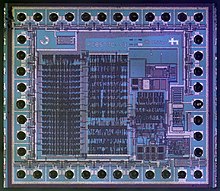This article needs additional citations for verification. (July 2019) |

In electronics/computer hardware, a display driver is usually a semiconductor integrated circuit (but may alternatively comprise a state machine made of discrete logic and other components) which provides an interface function between a microprocessor, microcontroller, ASIC or general-purpose peripheral interface and a particular type of display device, e.g. LCD, LED, OLED, ePaper, CRT, Vacuum fluorescent or Nixie.
The display driver will typically accept commands and data using an industry-standard general-purpose serial or parallel interface, such as TTL, CMOS, RS-232, SPI, I2C, etc. and generate signals with suitable voltage, current, timing and demultiplexing to make the display show the desired text or image.
The display driver may itself be an application-specific microcontroller and may incorporate RAM, Flash memory, EEPROM and/or ROM. Fixed ROM may contain firmware and display fonts.
A notable example of a display driver IC is the Hitachi HD44780 LCD controller. Other controllers are KS0108, SSD1815 (graphics capable) and ST7920 (graphics capable)